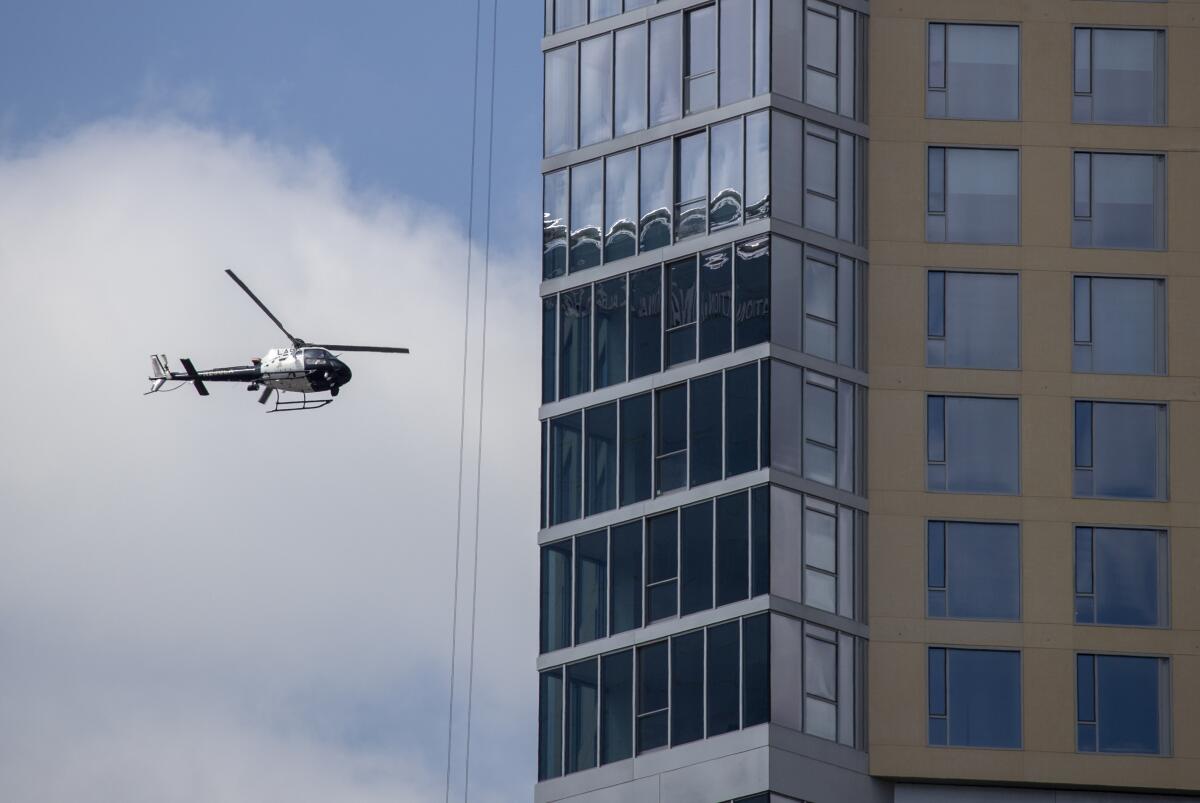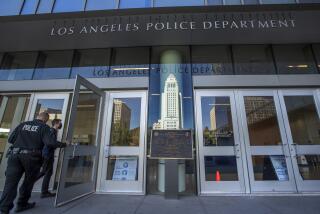A man with a knife was shot by police. Then an LAPD helicopter made things worse

- Share via
The police shooting began like so many others.
Los Angeles Police Department officers responded to a call of a man with a knife acting erratically. One opened fire when the man came at them aggressively.
If it had ended there, the man probably would still be alive. But a police helicopter swooped noisily in, another patrol car arrived, and the chain of events that followed left the man lying on the ground with gunshot wounds that would eventually kill him.
The death of Samuel Soto — and the unavoidable realization that it likely could have been prevented — was a rare but stark reminder to LAPD officials that their heavy reliance on the department’s fleet of helicopters carries with it the potential for unintended tragedy.
A detailed account of how the 53-year-old Soto died was included in a report that LAPD Chief Michel Moore sent recently to the civilian Police Commission. The commission last week ruled unanimously that the officers involved in Soto’s killing did not violate department policies.
It was an off-duty police officer visiting L.A. from San Antonio who called 911 about 8:45 p.m. on July 26 last year. He told the operator a man just off Pico Boulevard on Union Avenue was cutting himself with a knife, according to the report.
Officer Eduardo Martinez and his partner, Ruben Mejia, arrived minutes later. Seeing Soto in the street with the knife, they jumped out of their vehicle and drew their weapons. On video from body cameras that was released after the shooting, one of the officers is heard saying, “Hey, let me see your hands, bro!”
Soto instead charged toward Martinez, who fired two rounds at him, missing both times, the report said. Undeterred, Soto continued advancing toward Martinez, who fired once more, this time striking Soto and causing him to fall to the ground.
The knife fell from Soto’s hand and Mejia approached, kicking the weapon out of Soto’s reach.
Mejia had put out a call for help over his radio — as police are required to do after a shooting — and several officers sped toward the scene.
The radio traffic also got the attention of officers flying in “Air 10” — an LAPD helicopter.
In Los Angeles, the department’s airships are a common sight and soundtrack of the city. The LAPD began using its first helicopter in 1957 to help monitor traffic along the city’s burgeoning highway system. Two decades later, it formed the Air Support Division. The unit now has 18 helicopters, two of which are often in the air at a given moment.
The LAPD operates one of the largest municipal fleets in the country, which it says plays a valuable role in tracking crime suspects and patrolling the city from above. Yet, the helicopters are also a source of frustration and distrust for many people, who consider them an unwelcome intrusion and reminder of what they see as the LAPD’s overbearing presence.
The pilot flying Air 10 arrived over the shooting scene and maneuvered the helicopter lower toward the street.
As he did, the wounded Soto was pushing himself up to his feet. Martinez and Mejia screamed at him to stop moving. Ignoring the commands, Soto began running toward Martinez, who backed away.
The first officers to respond to the help call were Officer David Voci and his partner. They arrived to a chaotic scene and drew their weapons. Voci told investigators that he saw Soto advancing on Martinez and assumed he was still armed with a knife. Martinez and Mejia, he noticed, both had “urgent” expressions, according to Moore’s report.
The chop of the helicopter’s blades and roar of its engine filled the air.
Uncertain if Soto had dropped the knife, Martinez asked Mejia whether he was still armed. “No, no, no, he doesn’t have the knife!” Mejia shouted back. “He doesn’t have the knife!”
Mejia then shouted at Voci and his partner to tell them the same thing. No knife.
But the helicopter was too low and too loud. Voci said he could hear a jumble of voices yelling over the din of Air 10, but couldn’t tell who was speaking or what was being said. The only word he could make out, shouted over and over, was “knife, knife,” he said.
When Soto then turned in Voci’s direction and put his right hand behind his back, Voci shouted at him, “Drop it!” Soto continued toward him and Voci could see an object in his hand. Voci fired three rounds. Soto collapsed to the ground — a cellphone in his hand.
Soto died of his injuries five months later. The death prompted California Atty. Gen. Rob Bonta’s office to open its own investigation of the shooting. It is ongoing.
It was not the first time an LAPD helicopter had added to the confusion of an already difficult situation.
In May 2020, a pilot hovered overhead after the shooting of Rommel Mendoza. Mendoza, 50, was killed in North Hollywood after facing off with officers while wielding a sword and asking to be shot. According to a report at the time, officers on the scene complained to investigators that the helicopter was flying “very low” and was “very loud,” making their jobs difficult.
And in May 2007, before LAPD officers violently cleared MacArthur Park of a largely peaceful crowd of protesters, the noise from a police helicopter made it impossible for protesters to hear an order to disperse.
Daniel Schwarzbach, executive director of the Airborne Public Safety Assn., a trade group, said that although air support is a valuable policing tool, it can cause confusion at crime scenes.
“I have been on the scenes myself where the noise from the aircraft was hampering communication on the ground,” said Schwarzbach, who spent 38 years with the Houston Police Department, 30 of which were spent flying helicopters.
As a pilot, he said he tried to communicate with officers on the ground and to be ready to gain altitude if the situation called for it.
In his report, Moore did not address what help, if any, the officers in the helicopter provided to the others on the ground and whether the helicopter should have been there at all. In a footnote, the chief said the head of the Air Support Division was told to discuss with officers “dynamic situations and the possibility of gaining altitude to enhance communications between personnel on the ground.”
Although the commission found Martinez and Voci had been justified in using deadly force, Moore’s report cited other points during the incident in which officers strayed from department policies for how to handle people who are armed and in crisis.
Neither of the initial officers, Moore wrote, had a working taser because of a battery shortage. Investigators learned that the shortage had existed for months and affected several divisions throughout the department.
According to Moore, the problem was solved after the department adopted a newer version of the device, which can be used to briefly incapacitate an uncooperative suspect by shocking them with an electric charge.
Moore disagreed with the majority of an internal LAPD review panel, which faulted an officer who arrived on the scene after Soto’s shooting and tried to restrain him by stepping on Soto’s calf — a move discouraged by the department. The chief declined to discipline the officer.
In his report, Moore noted that while officers are trained to take their time and de-escalate incidents like the one that led to Soto’s shooting, the man’s refusal to drop the knife as he approached police necessitated quick action.
The revelations in the Soto case come as the family of another man fatally shot by the LAPD filed a wrongful death claim against the city, contesting a police account that 30-year-old Rodolfo Torres pointed a gun at officers before they opened fire on him on a South Los Angeles block this month.
Justin Sterling, an attorney for Torres’ family, said that he filed the claim on Friday, typically a first step toward a lawsuit, and has asked the department to release any body-camera footage from the incident.
Torres was killed July 2, after police responded to a report of a man firing a gun and encountered Torres in the area of 36th Place and Maple Avenue, Moore told the Police Commission last week.
Torres appeared under the influence of drugs or alcohol, ignored police commands to stop walking and to get his hands out of his pockets, Moore said. At one point, police shot him with a 40-millimeter foam tip launcher, sending Torres tumbling to the ground.
Moore said that Torres refused to drop a gun while on the ground. Officers opened fire when he pointed the gun at them, fatally wounding him, Moore said. No officers or bystanders were injured in the shooting. Torres died sometime later at a hospital.
A video recorded on a bystander’s cellphone and seen by The Times shows the moments before officers opened fire on Torres, who was lying on the street.
The video, taken from about half a block away, shows a group of officers with their guns and flashlights trained on Torres, barking orders as they slowly back away. It is not possible to see whether Torres is holding a gun.
Suddenly, a crackle of gunfire is heard as the camera cuts away.
More to Read
Sign up for Essential California
The most important California stories and recommendations in your inbox every morning.
You may occasionally receive promotional content from the Los Angeles Times.











